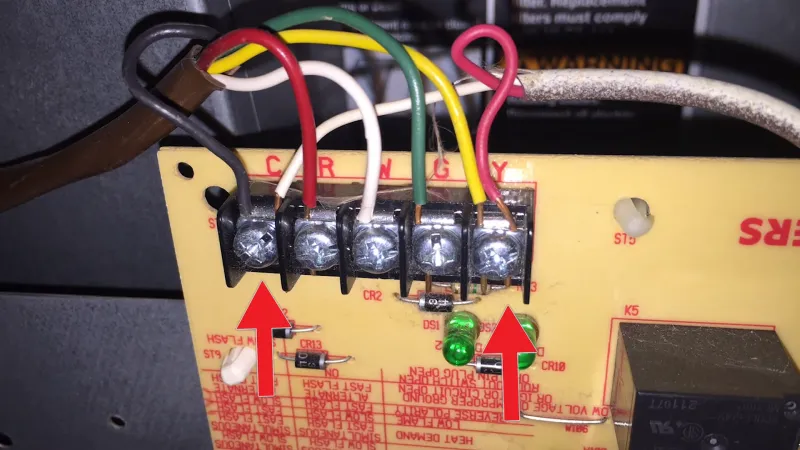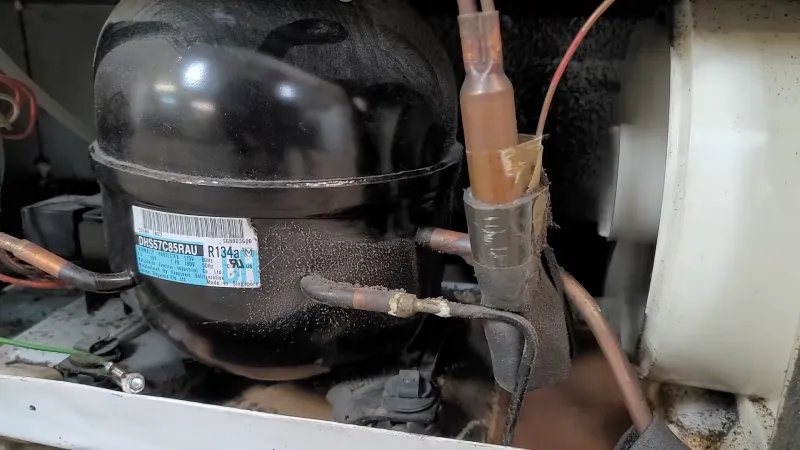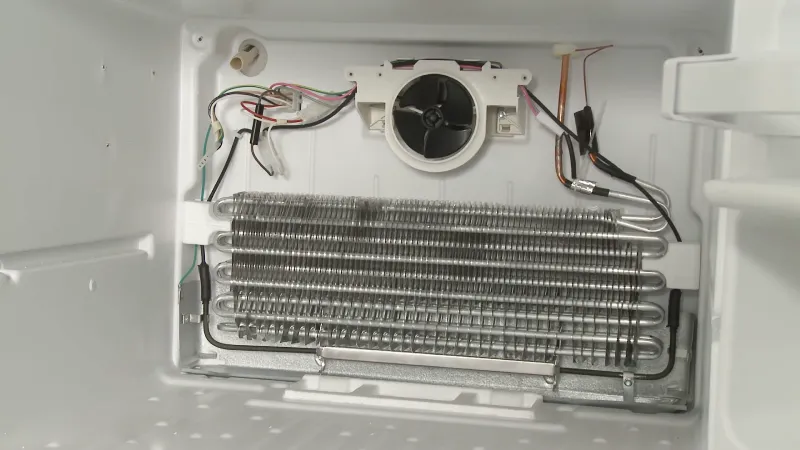GE Profile Refrigerator Motherboard Problems and Solutions
The motherboard, also known as the main control board, plays a crucial role in the functioning of a GE Profile refrigerator. It acts as the central processing unit, controlling various functions such as temperature regulation, defrosting, and light activation.
When the motherboard experiences problems, it can lead to a range of issues with the refrigerator, impacting its overall performance and efficiency. In this article, we will explore 5 to 10 common motherboard problems that can occur in GE Profile refrigerators and their potential solutions.
You'll Learn About
Problem #1: Error Code 0000
The Role of the Motherboard in a GE Profile Refrigerator A refrigerator is an essential appliance in any household and having it function properly is key to keeping food and drinks at the desired temperature.
The motherboard, also known as the main control board, is the central component that controls the various functions of a GE Profile refrigerator. It receives inputs from various sensors, such as the temperature sensors, and provides the necessary output signals to operate the various components such as the compressor and fan motors.
A malfunctioning motherboard can cause a range of issues that can significantly impact the operation of the refrigerator.
The Error Code 0000 on a GE Profile refrigerator is an indication that the motherboard or main control board is defective. This error code will appear on the control panel display and may prevent the refrigerator from functioning properly.

Causes of the Error Code
The Error Code 0000 may be caused by a variety of factors including a power surge, a short circuit in the wiring, or simply a component failure on the motherboard. It is important to identify the cause of the error code to determine the appropriate course of action for repair.
Troubleshooting Steps for the Error Code
There are a few steps that can be taken to troubleshoot the Error Code 0000:
- Reset the Refrigerator: Power off the refrigerator for a few minutes and then turn it back on to see if the error code disappears.
- Adjust the Temperature: Check the temperature settings and ensure that they are set properly.
- Replace the Motherboard or Control Board: If the Error Code 0000 persists, it may be necessary to replace the motherboard or control board entirely.
the Error Code 0000 on a GE Profile refrigerator is a serious issue that needs to be addressed promptly. The motherboard is a critical component of the refrigerator, and a malfunctioning motherboard can cause significant problems with the operation of the refrigerator. The steps outlined in this article can help troubleshoot the Error Code 0000, but if the problem persists, it is advisable to consult a professional appliance repair service to diagnose and repair the issue.
Problem #2: Loud Noise
One of the most common complaints about GE Profile refrigerators is that they can become quite loud. This loud noise can be disruptive, especially if the refrigerator is located near a bedroom or living space. There are several potential causes of loud noise in GE Profile refrigerators, so it is important to diagnose the source of the noise in order to address it effectively.
Causes of Loud Noise in a Ge Profile Refrigerator
Loose Door Seal
A loose door seal is a common cause of loud noise in GE Profile refrigerators. If the door seal is not tight, it can allow cold air to escape from the fridge. This can cause the fridge to work harder to keep the inside cool, which can result in loud noise.

Fan Blade
Another potential cause of loud noise in GE Profile refrigerators is a fan blade that is hitting something. If the fan blade is hitting the fan housing or another component, it can cause a loud noise.
Compressor
The compressor can also be a source of loud noise in GE Profile refrigerators. If the compressor is running loudly, it may indicate a problem with the refrigerant system or a failing compressor.

Evaporator Fan Motor
The evaporator fan motor can also be a source of loud noise in GE Profile refrigerators. If the evaporator fan motor is worn out or failing, it can make a loud noise when it is running.
Troubleshooting Steps for Reducing Noise
Check the Door Seal
If you suspect that the door seal is loose, you can check it by closing the door on a dollar bill. If you can easily pull the bill out, the door seal is likely too loose.
Check the Fan Blade
If you suspect that the fan blade is hitting something, you can check it by unplugging the refrigerator and rotating the fan blade by hand. If the fan blade is hitting something, you may be able to see it or feel it as you rotate the blade.
Check the Compressor
If you suspect that the compressor is the source of the loud noise, you can unplug the refrigerator and listen for the noise. If the compressor is the source of the noise, you may need to call a professional to diagnose and repair the issue.
Check the Evaporator Fan Motor
If you suspect that the evaporator fan motor is the source of the noise, you can unplug the refrigerator and listen for the noise. If the evaporator fan motor is the source of the noise, you may need to call a professional to diagnose and repair the issue.
Problem #3: Blown Resistor
A resistor is a passive electrical component that limits the flow of current in an electrical circuit. In a GE Profile refrigerator, the resistor is responsible for regulating the current flow to the compressor, fan, and other components. If a resistor fails, it can cause a range of problems, including a blown fuse, faulty compressor, or even a malfunctioning fan.
Causes of a Blown Resistor in a Ge Profile Refrigerator
There are several reasons why a resistor in a GE Profile refrigerator might fail. Some of the most common causes include:
- Overloading the electrical circuit
- A power surge or voltage spike
- Poor wiring or electrical connections
- Degraded insulation or damaged electrical components
- A malfunctioning compressor or fan
Troubleshooting Steps for a Blown Resistor
If you suspect that a resistor in your GE Profile refrigerator has blown, there are several steps you can take to troubleshoot the problem:
- Unplug the refrigerator and turn off the power source.
- Locate the resistor and check for any visible signs of damage, such as melted insulation or burnt wires.
- Check the wiring and electrical connections for any signs of degradation or corrosion.
- Test the voltage and current levels in the electrical circuit using a multimeter.
- Replace the resistor if it is damaged or burnt out.
It is important to note that replacing a resistor can be a complex and potentially dangerous task that should only be performed by a qualified technician. If you are unsure about your ability to replace a resistor in your GE Profile refrigerator, it is best to call in a professional for assistance.
Problem #4: Loose Door Seal
The door seal, also known as the gasket, is a crucial component of the GE Profile refrigerator. It is located around the door and is designed to keep cold air inside the refrigerator and prevent warm air from entering.
The door seal is made of rubber or plastic material and is crucial in maintaining the temperature of the refrigerator.
Causes of a Loose Door Seal in a Ge Profile Refrigerator
There are several reasons why a door seal may become loose, including:
- Age and wear and tear: Over time, the door seal may become brittle and crack, which can lead to air leaks and loss of cooling.
- Improper alignment: If the door is not properly aligned, it can put pressure on the door seal and cause it to become loose.
- Frequent opening and closing: Repeated opening and closing of the door can cause the door seal to become loose over time.
- Exposure to heat: Exposure to heat can cause the door seal to become soft and lose its shape, which can lead to a loose door seal.
Troubleshooting Steps for a Loose Door Seal
Here are some steps you can take to fix a loose door seal in your GE Profile refrigerator:
- Clean the door seal: Use a damp cloth to clean the door seal, removing any dirt or debris that may be causing it to become loose.
- Realign the door: If the door is not properly aligned, it can put pressure on the door seal and cause it to become loose. Check to see if the door is properly aligned and make any necessary adjustments.
- Replace the door seal: If the door seal is damaged or worn, it may need to be replaced. Contact a professional or follow the manufacturer’s instructions to replace the door seal.
- Minimize exposure to heat: Try to avoid exposing the door seal to heat, which can cause it to become soft and lose its shape.
Problem #5: Scorched Board
A scorched board refers to a damaged motherboard in a GE Profile refrigerator. The motherboard is the central component that controls all the functions of the refrigerator, including cooling and temperature regulation. If the motherboard is damaged, it can result in a variety of problems that can affect the performance of the refrigerator.
Causes of a Scorched Board in a Ge Profile Refrigerator
There are several reasons why a GE Profile refrigerator’s motherboard can become scorched. Some of the most common causes include electrical surges, power outages, and incorrect voltage supply. Another possible cause is a short circuit, which can occur if the motherboard comes into contact with water or other liquids.
In some cases, a malfunctioning component, such as a fan or a relay, can cause the motherboard to overheat, leading to a scorch.
Troubleshooting Steps for a Scorched Board
If you suspect that your GE Profile refrigerator’s motherboard is scorched, it is important to take immediate action. The first step is to unplug the refrigerator and turn off the power supply to prevent further damage.
Next, inspect the motherboard for signs of scorching or other damage. If the damage is severe, it is recommended that you replace the motherboard. In some cases, it may be possible to repair the scorched board by replacing damaged components or soldering new components into place.
However, it is best to consult a professional technician if you are not experienced in repairing electronic components.
A scorched board is a serious problem that can affect the performance of a GE Profile refrigerator. If you notice signs of a scorched board, it is important to take immediate action to prevent further damage and to ensure that your refrigerator continues to operate at peak performance.
Problem #6: Refrigerator Not Cooling Evaporator Fan Not Running
A problem with the evaporator fan may occur if the fan motor or the fan belt is defective. This can cause the evaporator fan not to run, which will lead to a reduced cooling ability of the refrigerator.

Potential Causes of a Fan Problem
There are several possible causes of a fan problem, including:
- Fan belt: It is important to regularly check the condition of the fan belt for signs of wear or damage. If the fan belt is worn out or damaged, it can cause the evaporator fan to not turn on or not run at full speed.
- Faulty wiring: The evaporator fan may not turn on if there is a problem with the circuit board, causing the motor to stop working.
- Misaligned belt: Misalignment of the fan belt may also prevent the evaporator fan from working correctly, leading to a reduced cooling ability.
- Safety: If the belt is damaged or the fan is not working properly, it may not be properly cooled, which can cause a freezer fire.
If the fan or its belt is faulty, it is important to take immediate action to ensure that the problem is resolved.
Check the fan to see if it is running or not running. If the fan is running but not cooling, it can be caused by a variety of reasons. It is important to check the entire refrigerator for signs of leaks or other damage, which can also cause a loss of cooling.
You can also try cleaning the evaporator coil. Cleaning the evaporator coil using warm water and a soft, cloth cloth. The cooling coils should be washed once a year to ensure that they remain clean.
Problem #7: Constant Clicking Noise
Constant clicking noise is a common issue that affects a lot of GE Profile refrigerators. A constant clicking sound usually indicates that a malfunctioning component is the source of the problem. It is important to check the source of the noise, such as a fan or electrical component.
Causes of a Constant Clicking Noise in a Ge Profile Refrigerator
The source of the constant clicking noise may be related to a component in the fridge, such as a fan or electronic component. However, a number of different factors can contribute to a constant clicking noise. For example, if the refrigerator is in the closed position and there is a build-up of water vapor in the internal components, the fan can create an internal pressure that can cause the noise.
Troubleshooting Steps for a Constant Clicking Noise
Here are some troubleshooting steps you can take to try to fix a constant clicking noise in your GE Profile refrigerator:
- Check to see if the freezer is cold enough: If the freezer has ice cubes or food in it, it may be making noise due to a buildup of water vapor in the component.
- Inspect the area: If the refrigerator is running, you can look for signs of a malfunctioning fan or a faulty electronic component.
- Check the refrigerator’s wiring: If the clicking sound is electrical, it is possible that the problem is the electrical wiring that runs from the refrigerator to the plug, causing the noise.
- Remove any objects: The constant clicking noise can be caused by a buildup of ice and water in the freezer, which can be prevented by opening the freezer periodically to allow the ice to melt.
If your GE Profile refrigerator is making a constant clicking sound, you can take immediate action to fix the problem. However, if the clicking sound continues, contact a technician to ensure it is repaired properly.
Conclusion
The motherboard plays a crucial role in the proper functioning of a GE Profile refrigerator. The common motherboard problems discussed in this blog such as Error Code 0000, loud noise, blown resistors, loose door seal, and scorched board can cause significant inconvenience if not addressed promptly.
Each of these problems has its specific causes and troubleshooting steps, but prompt repair is essential for the proper functioning of the refrigerator. It is recommended to seek professional assistance if you are unsure about handling the repair process.
In summary, being aware of these common GE Profile refrigerator motherboard problems can help you take proactive measures and prevent significant damages to your appliance.

